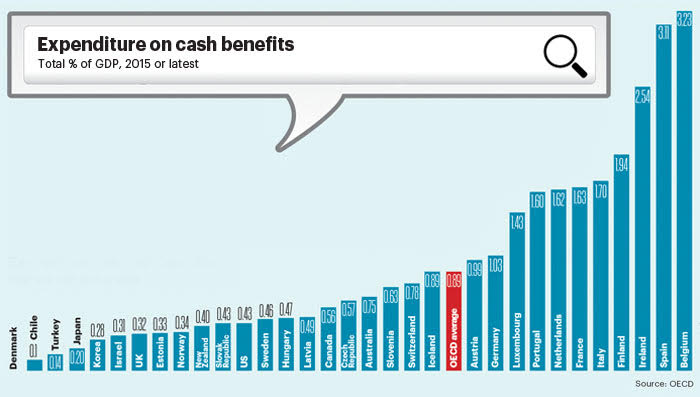Quick wins:
Greek gift: Greece exited its final eurozone bailout in August. The rescue package totalled €288.7bn – the largest amount ever disbursed by international creditors. European commissioner for economic and financial affairs Pierre Moscovici said the “worst is over” after eight “very difficult” years.
Baby boom: There has been speculation that China could be set to further relax its stringent family planning rules. Currently, Chinese families are restricted to a maximum of two children, itself a relaxation of the notorious one-child policy that endured from 1979 until 2016 and aimed to limit the size of the population.
India sets the pace: Economic growth in India makes up 15% of growth globally, according to the International Monetary Fund. The country is on track to becoming the fastest growing economy in the world, with its momentum described as an “elephant beginning to run”. Growth of 7.3% is expected this fiscal year, rising to 7.5% next year.
Spotlight on unemployment
Belgium, Spain and Ireland spend the greatest proportion of gross domestic production on unemployment benefits across the OECD area, at 3.23%, 3.11% and 2.54% respectively. This compared to an OECD average of 0.89%. Spain has an unemployment rate of 16.1%, well in excess of the OECD average of 5.4%.
Belgium and Ireland have unemployment rates much closer to the mean at 6.1% and 5.9% respectively. At the other end of the scale, Denmark, Chile, Turkey and Japan spent the least on unemployment. Japan has one of the lowest unemployment rates in the OECD at 2.4%, while Turkey’s is relatively high at 9.8%.
The OECD defines public unemployment spending as expenditure on cash benefits to compensate people for being out of work. This includes any publicly funded redundancy payments as well as paying pensions to beneficiaries under the standard pension age.
Violent death rate falls
Homicide rates have fallen in some countries, World Bank data has revealed. South Africa, Colombia, Paraguay, Kazakhstan and Albania have seen the biggest falls. Rates in South Africa and Colombia at more than 30 per 100,000 people are still well in excess of the global average, which is under 10.Sustainable Development Goal 16 focuses on peace and justice – reducing deaths from violence (16.1) is a chief indicator.
Put a stop to corruption
 Sustainable Development Goal (SDG) 16 also focuses on reducing corruption and bribery (16.5), with a focus on bribery between public officials and businesses. World Bank data shows that bribery expectations are highest in the East Asia & Pacific region followed by the South Asia region.
Sustainable Development Goal (SDG) 16 also focuses on reducing corruption and bribery (16.5), with a focus on bribery between public officials and businesses. World Bank data shows that bribery expectations are highest in the East Asia & Pacific region followed by the South Asia region.
Expectations of gifts from public officials is lowest in Latin America & Caribbean and Europe & Central Asia regions. Globally, almost a quarter of firms said they expected to give gifts to public officials.

US against the world
Americans have only a lukewarm view of the some of the US’s key allies, according to research by the pollster Gallup. The leaders of Canada, the UK, Germany and Israel were viewed more favourably than unfavourably, but ratings for all fell below 50%, while unfavourable ratings ranged from 21% for British PM Theresa May to 29% for Israel’s premier Benjamin Netanyahu. The leaders of two of the US’s biggest antagonists – Russia’s Vladimir Putin and North Korea’s Kim Jong Un – both have very high unfavourable ratings at 76% and 84% respectively. Breaking the data down, Republicans were more positive towards Netanyahu, Putin and slightly more so to Kim. Democrats had more favourable views of Canada’s Justin Trudeau and Germany’s Angela Merkel.
City-centric
 The world has seen some major urbanisation over the past 10 years. Since 2008, most people in the world live in urban areas. Only the South Asia region and the Sub-Saharan Africa region remain more rural than urban, while the population is highly concentrated in urban areas in the Americas. Since 1980, the East Asia & Pacific region, which includes China, Indonesia and the Philippines, has seen a particularly marked shift in people towards urban areas, accompanied by declining rural populations.
The world has seen some major urbanisation over the past 10 years. Since 2008, most people in the world live in urban areas. Only the South Asia region and the Sub-Saharan Africa region remain more rural than urban, while the population is highly concentrated in urban areas in the Americas. Since 1980, the East Asia & Pacific region, which includes China, Indonesia and the Philippines, has seen a particularly marked shift in people towards urban areas, accompanied by declining rural populations.
Water, water everywhere
Nine out of ten people around the world had access to improved water sources in 2015, up from 76% in 1990, according to Oxford University’s Our World in Data project. Across the planet, that means 6.69 billion people can access either piped water in their households, public taps or standpipes, tube wells or boreholes or protected dug wells and springs.
While the World Bank’s definition of an ‘improved water’ source does not guarantee that water is safe to drink or that the supply is adequate, it is more likely than an ‘unimproved’ source to be safe and free from human excreta, the project noted. Access to improved water still remains low in sub-Saharan Africa, where rates typically range from 40% to 80% of households.









